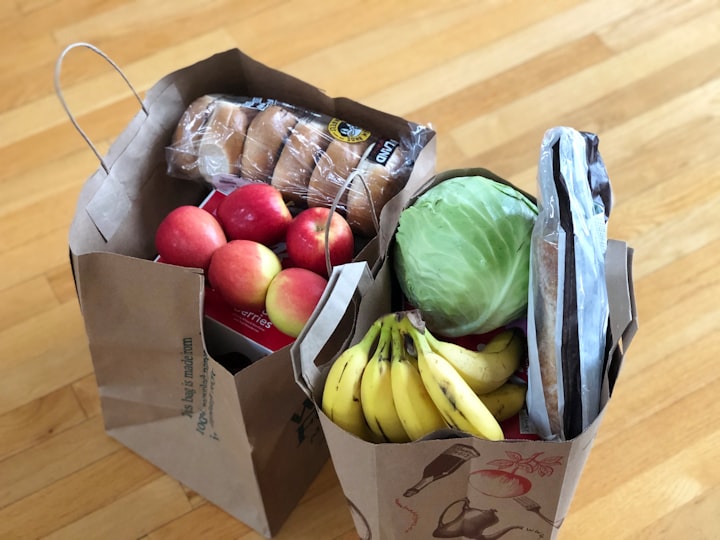Food Budgeting Tips for Beginners
Level One: The First Five Steps

With inflation on the rise, many individuals and families are becoming more aware of the overall price of foods, goods, and services. While some state they don't want to talk about it, others are bringing it up as a constant topic of conversation. Regardless of which side of the coin you are on, it is likely that everyone wants to save more money.
Budgeting has been and will always be an important part of my family's everyday life. Abiding by the term "living within our means" has yet to let us down, and has provided us a great deal of security and comfort when times have been tough. Whether inflation has you a little worried or a drop in income has you down, it may ease your mind to know there are actions you can take to mitigate these potential issues. Tightening up your grocery budget is one of those means.
Grocery budgeting can usually be tightened up at any experience level (including what some may call the lunacy level of yours truly here.) For this publication, however, we will start off at the beginner-novice experience level of grocery budgeting and work our way to the more experienced budgeting levels. Everyone has to start somewhere, and the more easily digestible the information, the more willing you will be to stick to the budget.

1. Track your grocery spending habits for one month.
The first step to take when creating a budget is to observe your usual spending habits over a typical, (not holiday), month. Spend as you normally would, but keep track of when, where, and what. Developing a budget you think is reasonable based on national average or other individuals' spending habits, may prove difficult for you depending on how much you actually spend each month. Whittle your budget down slowly as you make adjustments; don't set unreasonable expectations for yourself or you'll fail.
While keeping track of your grocery spending, be sure to include an additional category for dining out meals, take out, or delivery. If it is a consumable food or beverage, it should be included in your budget. Yes, even that occasional coffee. Making separate categories within that budget will make things easier to track for the next month.
A word of caution here: do not shame yourself for what you are spending as you observe your habits. When you truly take a look at your spending habits, you may notice things you do not want to see. Try to move beyond fixating on this, and utilize it as fuel for why you want to make budgetary changes.
2. Find beneficial reasons for motivation.
Maybe you already had another reason you wanted to make budgetary changes when you viewed step one or maybe it was simply "to save money." For many of us, the vague reason "to save money" is not a huge long-term motivator. This reason will catch our attention much like a "get rich quick scheme" at first glance, then we'll discount it completely and it will all be forgotten. We all want to save money, but the question is what is that money actually worth to us and why do we want to save it?
Consider your own personal reason or reasons.
Are there other areas you would prefer to utilize the money you save by sticking to a grocery budget? Do you want to invest in the future; your retirement future, future generations, etc.? Do you want to learn new skills like how to cook or prepare your great-grandmother's recipe for your family? Do you want to live a healthier lifestyle or incorporate more whole foods, etc.? Narrow down your reasons for change to a list specific to your own individual goals.
While "necessity is the mother of all invention" for making budgetary changes, you may not want to procrastinate on changes that necessity will then dictate. Being proactive will help you adjust much more easily to that same necessity at a later point. Having time to practice something without a heightened sense of pressure tends to make learning skills much less stressful, especially when there is little room for error later on.
The more frugal your lifestyle, the easier it will be to sustain. Your investments may not be worth as much as you hope or expect in the long run, especially in cases of economic recession or depression, but the frugal choices you make as an individual can definitely help.
3. Create a realistic budget based on the observed month's spending habits.
Evaluate your spending habits with a critical, but kind eye. Depending on who you are, you may want to switch your perspective in order to do this. Some of us are either much harsher on or more defensive of ourselves when it comes to our spending habits than we would be to a dear friend or family member genuinely asking for our assistance. If this is the case for you, it may help to pretend that you are helping that loved one with their own budget, and process things accordingly for yourself from that perspective instead. After critiquing the past month's spending habits and arriving at your conclusions on adjustments, then return to your own point of view.
Be sure you feel comfortable with next month's budget goal. If you spent $500 on your family of four's groceries, maybe $450 or $480 seems like a reasonable goal to you. $480 may not seem like much of an improvement or much of a compromise either, but $20 of freed up income every single month equates to $240 a year more than you would have had before you budgeted, and that can make a difference. It is also possible that you would like to keep the budget the same ($500) to establish consistency if you are unsure as to whether you truly spend that amount month to month. The point is to find something you feel you can stick to that is realistic for your own individual needs at this stage of the process. Your comfort level is directly related to your confidence at this point, and you can build both up later on by challenging yourself further. You don't want any apprehension this early in the process. For now, you are simply trying to establish a better mindset for spending habits in this area.
4. Be aware of prices on goods you purchase and always check your store receipt.

This smart shopping habit requires observation, but can yield potentially large savings. It takes approximately two minutes to check a receipt, occasionally longer depending on how much or what you buy.
The first thing you want to check on the receipt is whether or not you actually received all of the items that were scanned. It is very easy for a cashier or even yourself via self-checkout to double scan an item. If this item was a pricier item, like meat for instance, imagine how much extra you spent on something you aren't bringing home.
Next, check to make sure any items that had multiple price tags scanned properly. Items that are "on sale", "manager special", "reduced", etc. may have had a higher price tag scanned instead of the lowest priced tag. You likely purchased them because you thought you were getting a deal, so ensure you received the deal you intended to purchase instead of paying the full price.
If you happened to purchase any sale or coupon items, you can verify that these came up properly as well, but sometimes this can get pretty advanced. You can choose to overlook this step for now or you can keep a copy of them on your phone or hold onto a paper copy to further compare your receipt against the sale's ad price. These copies come in handy if you need to go to the customer service desk for an item that came up incorrectly.
Last, check to make sure that the remaining items you purchased appear to be approximately the price you remember them being on your receipt. If it looks close to right, it likely is at this stage of your grocery budgeting and shopping experience. Once you are more practiced, you can look more closely at these items.
*A note about receipt checking: Checking your receipt is best if you are still inside the store after checkout (away from a high traffic area) or inside your vehicle in the parking lot. It is easier for store employees to see your items if you are still in the store in case they request validation. There have been several instances where I have returned to a cashier or customer service kiosk prior to leaving the store after noticing items that were double scanned or came up incorrectly. I know many people are uncomfortable about doing this or may view it as a waste of time, but many times it winds up being worthwhile. Be kind and polite when you ask them about it, and they'll likely help you easy enough. In my experience, employees have always been helpful about reimbursing my card for overcharges when errors were made.
This step can sound like a lot to ask depending on how much you buy on a regular basis, but it does not require a change in the quality, quantity, or type of products that you purchase and can save you more than you may realize in the long run. Just getting into the habit of checking your receipt makes a big difference with budgeting and catching mistakes in the long run. It also makes you more aware of what you are buying and items you could easily swap, which brings me to my next beginner's step.
5. Consider swapping items you purchased last month for cheaper alternatives.
You may be surprised at how under budget you come when you decide to purchase a cheaper brand of a similar item. Some of these brands could be a featured on sale brand or perhaps even a generic. Certain items may not have a different quality component to make up for the additional cost, but others may. This is the phase at which you may want to experiment. Make compromises on items you are willing to compromise on. Your willingness to try something new becomes important here; don't make yourself sacrifice something you love dearly right from the beginning. Again, the goal is to create healthy budgeting habits.
Say, for instance, that you like ice cream and don't want to cut your specific ice cream out of your grocery budget completely. But, you are willing to try alternatives. Look for a different brand of ice cream that is featured on sale and compare it to the more expensive brand you usually get. Check out the flavors that entice you and give it a try. If you really love the brand you usually get, you can even get a single tub of it "just to compare." Allow yourself choices, make a game of it, and be adventurous so it doesn't feel like a compromise. You might decide you like the thought of trying something new every so often or that you actually like the alternative brand better.
Occasionally, you can even find the same goods you love packaged in a different way. Take your favorite K-cup coffee blend, for example, and see about purchasing a larger ground bag instead. You can purchase pod inserts and use the bagged ground coffee in those instead, which means you can get more of the same item you enjoy for cheaper. You may have to experiment with the quantity of grounds you put into the reusable insert, but once you have that figured out it may not feel like a concession. The same process can be applied for many groceries, including snack food items.
The swaps you choose to make should be according to your or your family's preferences early on, and remember any adjustments you make are a step in fine tuning your grocery budget in the long run.

These first five steps are not a comprehensive list of budgetary reductions that an individual or family can undergo. Instead, these are mere habits to practice. This beginning level article is about creating positive habits that fine tune and free up a little money without substantial effort. In the upcoming weeks, I plan to follow this up with a Level 1: Part Two: Steps 6-10 that will go into greater detail and touch on a few items previously mentioned. For now, I hope to have given you enough helpful, digestible tips for your next grocery budgeting adventure. Thank you for reading!
About the Creator
E.L. Martin
Powered by Nature, Humanity, Humor, Food, Lifestyle, Fiction, and Culture; Oh, and a questionable amount of coffee.
Reader insights
Nice work
Very well written. Keep up the good work!
Top insights
Easy to read and follow
Well-structured & engaging content
Expert insights and opinions
Arguments were carefully researched and presented
Eye opening
Niche topic & fresh perspectives
On-point and relevant
Writing reflected the title & theme






Comments (1)
I like when you mention "not to shame yourself" but to take inventory about spending habits. I found article very insightful especially during these difficult times